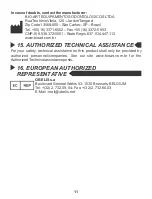
7
_______
Bio-Art Microblaster is equipment exclusively designed to produce a
_______
abrasion function blast, without prophylaxis function, i.e., there is no any
_______
similarity with sodium bicarbonate blasting equipment.
8. MAINTENANCE AND CLEANING
9. SAFETY PRECAUTIONS
Before disconnecting Microblaster from the compressed air network or
the equipment, remove the tank for abrasive (06) and then place your finger on the
tip of the ejecting needle (01) closing the needle orifice, and simultaneously press
the switch button (04) for approximately three seconds for the internal hose to
totally empty the abrasive that might still be in the system. This process is called
“Retro-blasting”.
_______
The “Retro-blasting” procedure shall not be executed for more than five
_______
seconds, which might cause breakage of the tank for abrasive (06).
For the Microblaster cleaning and disinfection, use only a cloth
dampened with water or alcohol 70%.
_______
Bio-Art Microblaster shall never be sprayed with liquids; be submerged
_______
or sterilized in an oven or an autoclave, except for the removable nozzles
_______
(02 and 11) in the Plus model, which, after being released from the
_______
product, can be sterilized in autoclaves
.
Keep the compressed air network always free of moisture and oil,
always observing the efficiency of your compressor's coalescent filters.
For model Microblaster Plus, whenever changing the nozzles (02 and
11), carefully clean the nozzles' and the fixation nut's (12) thread in order to
eliminate possible aluminum oxide residues or dust and to avoid their damage or
locking.
Intraoral Use:
_______
Bio-Art Microblaster was developed for general use and mainly for
_______
application in laboratories. Its intraoral use can be based on health,
_______
safety rules and restricted to the exclusive technical responsibility of the
_______
Dental Surgeon or the responsible professional.
































